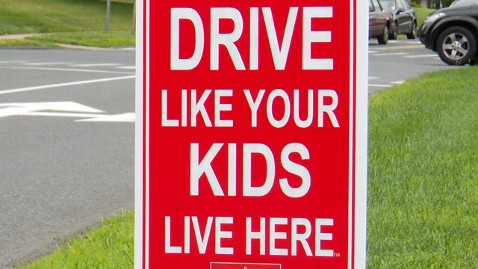Would a Sign Reminding You of Your Own Kids Convince You to Put On the Brakes?

Image Credit: Courtesy Petulia Pugliares
Can you get people to change behavior by appealing to their hearts or emotions? That's a standard tactic for advertisers, and now one woman has taken a page from the Madison Avenue playbook to try to get people to drive safely.
Petulia Pugliares lives on a busy residential intersection in Wethersfield, Conn., south of Hartford. Her home sits smack between two elementary schools and a high school.
That doesn't seem to faze the drivers though. "Cars go by way too fast, especially during the morning and evening commute," says Pugliares, who has witnessed numerous accidents, and was even struck by a car herself as she walked the neighborhood. Frustrated, she came up with a simple campaign to try to get drivers to slow down.
Her message, printed on bright, red lawn and street signs reads " Drive Like Your Kids Live Here."
Pugliares' words seem to work. "It has that hit-home effect. It really resonates and makes them slow down," she told ABC News.
In his blog, Daniel Pink, author of the book "Drive: The Surprising Truth About What Motivates Us" calls this a classic "empathy" campaign, a sign that elicits "empathy in the viewer."
Lennon Flowers, who works to promote empathy programs in education through Ashoka, a nonprofit social change group, agrees. 'I think immediately they [drivers] picture their own child, and I would like to think as a result they step on the brake pedal a little bit. And if they're not thinking of their own child, they're thinking of a child they know," said Flowers.
The idea is catching on. Pugliares, who works as an insurance agent by day, has sold and donated 4,000 of the signs to cities, community organizations and schools.
The town of New Milford purchased 50 of the signs and now rotates them to different locations every few months to keep the message fresh for drivers. "People don't speed on their own streets, so that's the whole idea of 'Drive Like Your Kids Live Here,'" said police Sgt. James Dzamko .
Every year, around 15,500 pedestrians under the age of 14 are injured in vehicular accidents, and an average of 350 are killed, according to Safe Kids USA. Cities have turned to speed humps and speed cameras to try to convince drivers to slow down. Some homeowners rely on "Children at Play" signs.
Pugliares hopes her message is "new and fresh" enough to catch drivers' attention. In New Milford, police have helped out too with the campaign, printing postcards with the "Drive Like Your Kids Live Here" slogan on one side, and the fines for moving violations on the other side, touching not just hearts but wallets too.
ABC News' Daniel Marks contributed to this story